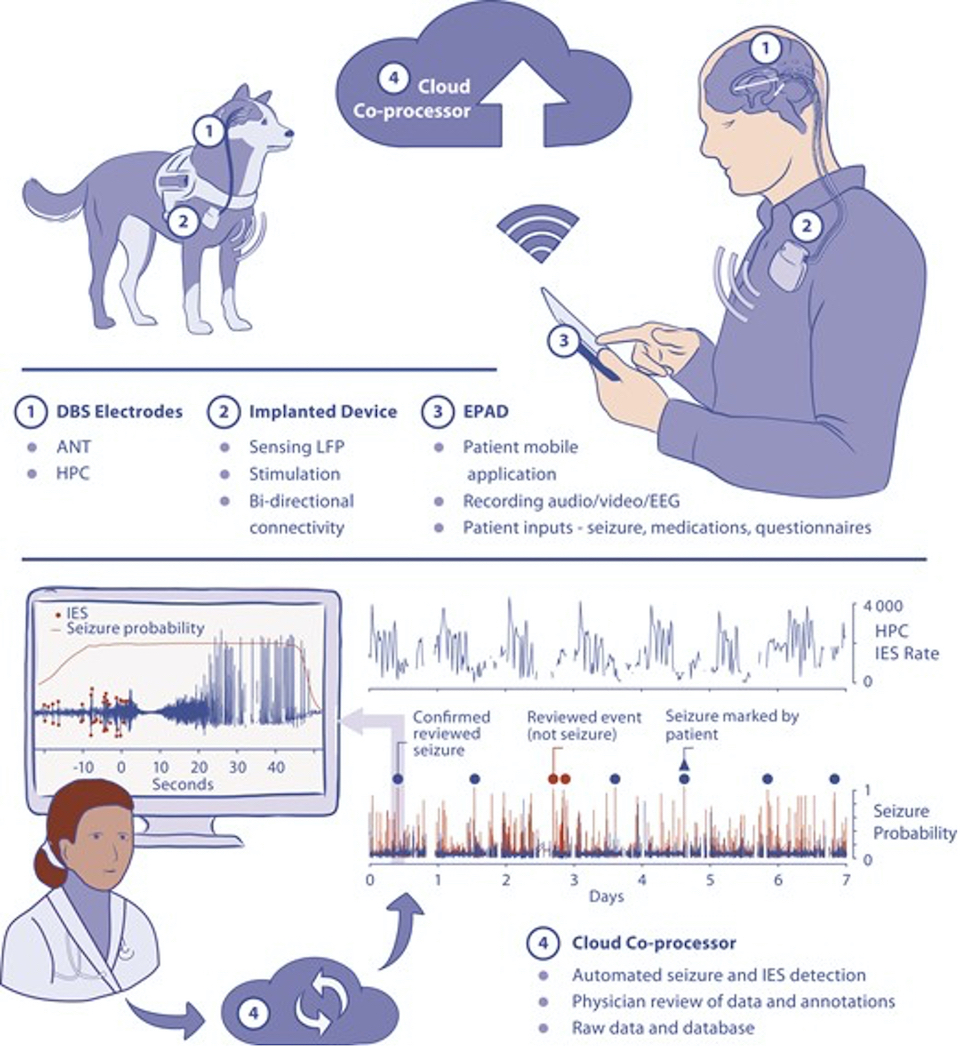Projects
Epilepsy

This is a disorder characterized by recurrent unprovoked seizures and affects over 50 million people worldwide. For many people, the seizures are not controlled by currently available medical therapies.
Treatment options for these patients include epilepsy surgery, vagus nerve stimulation and brain stimulation. Advances in neuroengineering have led to implantable devices that target specific neurological disease. Epilepsy is one of the most active areas with two first-generation stimulation devices recently proven in clinical trials. Results from brain stimulation trials using first-generation devices have demonstrated excellent safety, but improvements in efficacy are needed.
The Bioelectronics Neurophysiology and Engineering Lab is exploring many facets of epilepsy spanning:
- Development of epilepsy, known as epileptogenesis, in animal models.
- Spatial localization of epileptic brain using electrophysiology and multimodal imaging.
- The transition from regular brain activity to seizures, calledictogenesis, in human and animal models of epilepsy.
- Seizure forecasting.
- Diagnostic and therapeutic brain stimulation.
Multiscale electrophysiology
The Bioelectronics Neurophysiology and Engineering Lab has pioneered in the study of wide-bandwidth and high spatial resolution human brain electrophysiology. This research has focused on novel electrophysiological biomarkers, such as microseizures and pathological high-frequency oscillations. These biomarkers of epileptic networks are present at submillimeter spatial scales that are not detected with narrow bandwidth clinical recording technologies. The lab is using quantitative tools to analyze the spatial-temporal dynamics of putative pathological signatures of epileptic brain. These tools include:
- Microseizures.
- High-frequency oscillations.
- Ultraslow potentials, such as direct current (DC) shifts and epileptiform spikes.
Electrophysiological biomarkers
In a series of articles in Biomarkers in Medicine, the topic of epilepsy biomarkers was reviewed. The National Institutes of Health (NIH) defines a biomarker as an objectively measured characteristic of a healthy or pathological biological process, such as blood sugar in diabetes and prostate-specific antigen in prostate cancer. A surrogate biomarker is defined as an indirect measure of disease presence or progression. Emerging evidence from multiple laboratories indicates that pathological high-frequency oscillations and microdomain seizures are potential biomarkers of an epileptogenic brain.
The Bioelectronics Neurophysiology and Engineering Lab is currently investigating a range of electrophysiological biomarkers of healthy and epileptic brains to understand and track the processes by which healthy brain activity:
- Evolves into epilepsy, termed epileptogenesis.
- Spontaneously transitions to seizure activity, referred to as ictogenesis.
Multimodality imaging
Multimodality neuroimaging is used for functional characterization and precise anatomic localization. Identification of seizure-generating brain tissue using ictal single-photon emission computerized tomography (SPECT), positron emission tomography (PET), and structural and functional MRI and CT imaging is performed using advanced image-processing methods including statistical parametric mapping and FreeSurfer. Localization of intracranial electrodes in stereotactic and conventional intracranial electroencephalogram (EEG) implantation is performed using high-resolution MRI and CT imaging.
Brain stimulation diagnostics and therapeutics
This project is a collaboration with the International Clinical Research Center to advance the science and clinical translation of brain stimulation theranostics for neurological disease. The lab's team is investigating stimulation-response using transcranial stimulation and direct electrical stimulation combined with scalp and intracranial EEG.
AI-powered bioelectronic medicine
Currently, most therapeutic strategies for disease are either pharmaceutical or surgical. Bioelectronic medicine provides a complementary approach for directly manipulating the cells, circuits and systems that underlie many diseases. Bioelectronic therapy treats disease symptoms and has potential for restoration.
To correct the irregular signaling that underlies many diseases, the lab uses artificial intelligence (AI)-powered bioelectronic medicine. These therapies leverage advances in biology, engineering and AI to understand and manipulate the communication between cells, organs and systems. The implementation involves integrating implantable and wearable sensing and electrical stimulation devices with off-the-body AI coprocessors running on consumer devices such as iPhone and Android. The lab's goal is to create a system that directly senses, electrically stimulates and adaptively controls cellular biology and organ function.
The cornerstone of our group's efforts is an AI-powered bioelectronics platform. The lab's team has implemented this strategy in a proof of concept for canines and humans with epilepsy using a Medtronic research device, as an initial-use case. Expanding to other diseases is largely an engineering challenge. The technology elements — electrode interface, devices, computing, biological understanding — are poised for integration and rapid advance to serve our patients.
The Mayo Clinic Bioelectronic Platform will include an open-source system of biological interfaces, implantable and wearable devices, and AI-powered integration tools to enable disease tracking, digital phenotyping, prediction and adaptive therapeutic stimulation. Within a platform approach, the lab's investigators can provide the scientific, engineering and regulatory infrastructure for physicians to mount investigational device exemption (IDE) trials. The program will be tightly coupled to active extramural grants, entrepreneurship and industry collaboration.